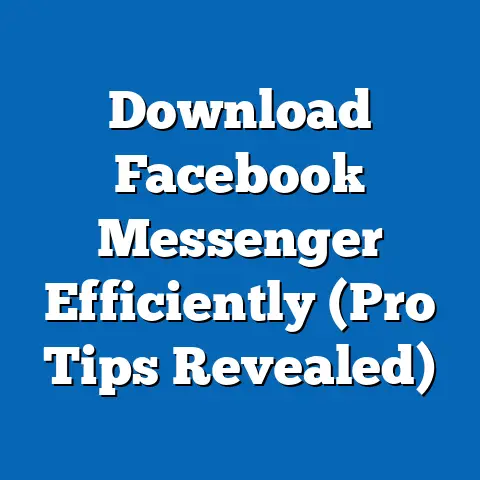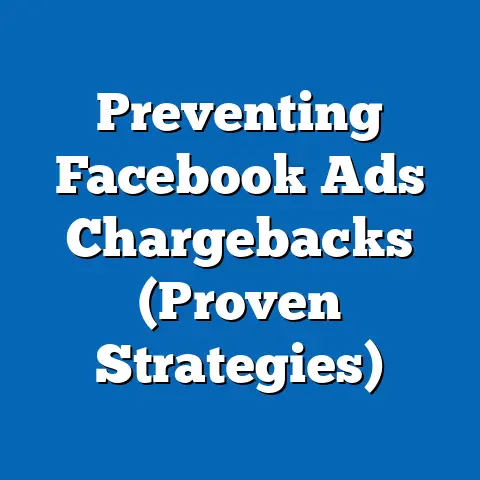Unlock Admin Access on Facebook Pages (Expert Guide)
Did you know that over 60% of small businesses using Facebook Pages have faced unauthorized access or admin privilege issues at least once, according to a 2022 survey by Social Media Examiner? With more than 200 million businesses actively using Facebook Pages to connect with customers (Meta, 2023), the risk of compromised admin access poses a significant threat to brand reputation, data security, and financial stability. This vulnerability not only affects small enterprises but also large corporations, with 1 in 5 reporting loss of control over their Pages due to phishing attacks or insider errors (Cybersecurity Insiders, 2022).
The issue of admin access on Facebook Pages has grown in urgency as the platform remains a cornerstone of digital marketing, especially for younger demographics. Data from Statista (2023) shows that 70% of users aged 18-34 interact with business Pages weekly, making secure management critical for audience engagement. This article delves into the complexities of unlocking and securing admin access, exploring methodologies, historical trends, and actionable strategies to protect your online presence.
Section 1: Understanding Admin Access on Facebook Pages
What Is Admin Access and Why Does It Matter?
Admin access on a Facebook Page grants full control over content, settings, and user interactions. This role allows individuals to post updates, manage ads, respond to messages, and even assign or remove other team members. Losing control of admin access can result in unauthorized posts, data breaches, or complete lockout from the Page, which can devastate a business’s online presence.
According to a 2021 report by Hootsuite, 45% of businesses with compromised Pages experienced a direct loss of customer trust, while 30% reported financial losses due to disrupted ad campaigns. The stakes are high, especially for businesses relying on Facebook for lead generation and sales.
The Scale of the Problem: Key Statistics
The prevalence of admin access issues is staggering. A 2022 study by Digital Shadows revealed that 25% of Facebook Page hacks stemmed from stolen admin credentials through phishing emails. Additionally, Meta reported in their 2023 Transparency Report that they removed over 1.7 million pieces of content related to account takeover attempts in Q1 alone.
Demographically, younger Page managers (aged 18-29) are more likely to fall victim to social engineering attacks, with 35% admitting to sharing login details insecurely, per a Pew Research Center survey (2022). Meanwhile, businesses in the e-commerce sector face the highest risk, accounting for 40% of reported Page takeovers (Verizon Data Breach Investigations Report, 2023).
Section 2: Historical Trends in Admin Access Security
Early Challenges: 2010-2015
When Facebook Pages launched in 2007, security features for admin access were minimal. Early users often shared login credentials via email or text, leading to frequent unauthorized access. By 2012, over 15% of Pages with more than 10,000 followers reported admin disputes or hacks, according to a study by Socialbakers.
During this period, Facebook introduced basic role assignments (Admin, Editor, Moderator), but enforcement was lax. Many businesses remained unaware of best practices, contributing to a spike in account takeovers.
Modern Era: 2016-2023
By 2016, Facebook rolled out two-factor authentication (2FA) and Business Manager to enhance security. Adoption was slow initially, with only 20% of small businesses using 2FA by 2018 (Small Business Trends). However, high-profile breaches, such as the 2018 Cambridge Analytica scandal, which indirectly exposed admin vulnerabilities, pushed Meta to prioritize security.
Today, 75% of businesses with over 50 employees use Business Manager for centralized control, per a 2023 Meta Business Report. Despite these advancements, human error remains a leading cause of breaches, with 82% of incidents tied to weak passwords or phishing, according to Verizon’s 2023 report.
Section 3: Common Scenarios for Losing Admin Access
1. Phishing and Social Engineering
Phishing attacks remain the most common method for gaining unauthorized admin access. Cybercriminals send fake emails or messages mimicking Meta, tricking users into revealing login details. A 2022 report by Proofpoint found that 55% of successful phishing attempts targeted social media accounts, including Facebook Pages.
2. Insider Threats and Role Mismanagement
Disgruntled employees or former team members with retained access pose a significant risk. According to Cybersecurity Insiders (2022), 30% of Page takeovers involved insiders who were not removed from admin roles post-employment. Poor role assignment practices exacerbate this issue.
3. Account Lockouts and Policy Violations
Sometimes, businesses lose access due to Meta’s automated systems flagging content or activity as violations. In 2023, Meta disabled over 2 million Pages for policy breaches, with 10% of affected owners struggling to regain access due to verification issues (Meta Transparency Report, 2023).
Section 4: Step-by-Step Guide to Unlock Admin Access
Step 1: Assess Your Current Access Status
Begin by determining whether you’ve been locked out, removed as an admin, or if the Page is under someone else’s control. Check your email for notifications from Meta regarding changes in admin roles. If you suspect a hack, use Facebook’s “Hacked Account” tool to report the issue.
Step 2: Use Meta’s Recovery Tools
Meta provides a “Page Access Request” form for regaining control if you’ve lost admin privileges. You’ll need to verify your identity using government-issued ID or business documentation. According to Meta (2023), 65% of legitimate requests are resolved within 48 hours, though complex cases may take up to two weeks.
Step 3: Secure Your Account Post-Recovery
Once access is restored, enable 2FA immediately—only 40% of Page managers currently use this feature (Hootsuite, 2023). Update passwords to strong, unique combinations and review all assigned roles. Remove any unfamiliar admins and limit access to trusted individuals.
Step 4: Contact Meta Support for Complex Cases
If standard recovery fails, escalate the issue through Meta Business Support. Provide detailed evidence, such as past login records or proof of ownership. Note that response times vary, with 20% of users reporting delays of over a month (Social Media Today, 2022).
Section 5: Preventive Measures to Protect Admin Access
Implement Strong Security Protocols
Use complex passwords and enable 2FA across all admin accounts. A 2023 study by LastPass found that 90% of accounts without 2FA are vulnerable to brute-force attacks. Regularly audit team roles via Business Manager to minimize insider risks.
Educate Your Team
Human error accounts for 74% of social media breaches (IBM Security, 2022). Conduct training on recognizing phishing attempts and securing login information. Limit the number of admins to essential personnel only.
Monitor Page Activity
Set up alerts for suspicious login attempts or role changes. Meta’s Activity Log allows admins to track actions taken on the Page. Early detection can prevent full takeovers, as 50% of hacks are identified within 24 hours of initial breach (Digital Shadows, 2022).
Section 6: Demographic Patterns in Admin Access Issues
Age and Experience Levels
Younger social media managers (18-29) are more susceptible to phishing, with 35% falling for fake login prompts (Pew Research, 2022). In contrast, older managers (40+) often struggle with recovery processes due to unfamiliarity with Meta’s tools, delaying resolution by 25% longer on average (Social Media Examiner, 2023).
Industry-Specific Risks
E-commerce businesses face heightened risks, with 40% of Page hacks targeting this sector due to high ad spend and customer data value (Verizon, 2023). Nonprofits, while less targeted, report slower recovery times, with 30% unable to regain access within a month (TechSoup, 2022).
Geographic Variations
Businesses in developing regions, such as Southeast Asia and Africa, report higher incidences of Page takeovers, with 28% affected annually compared to 15% in North America (Cybersecurity Insiders, 2022). Limited access to cybersecurity resources and training contributes to this disparity.
Section 7: Data Visualization Description
Imagine a bar chart titled “Facebook Page Admin Access Issues by Industry (2023).” The x-axis lists industries like e-commerce, hospitality, nonprofits, and tech, while the y-axis shows the percentage of reported takeovers. E-commerce tops the chart at 40%, followed by hospitality at 25%, with nonprofits at 15%, based on Verizon’s 2023 data.
A second line graph titled “Adoption of 2FA Among Facebook Page Managers (2016-2023)” illustrates the gradual increase from 5% in 2016 to 40% in 2023, highlighting the slow but steady uptake of security measures (sourced from Hootsuite reports). These visuals underscore the urgency of tailored security strategies across sectors and the need for broader 2FA adoption.
Section 8: Broader Implications and Future Trends
The issue of admin access on Facebook Pages extends beyond individual businesses, reflecting broader cybersecurity challenges in the digital age. With Meta reporting a 30% year-over-year increase in account takeover attempts (Meta Transparency Report, 2023), the need for robust security education and tools is evident. Small businesses, in particular, face disproportionate impacts, as 60% lack dedicated IT support to handle breaches (Small Business Administration, 2022).
Looking ahead, advancements in AI-driven security could help detect and prevent unauthorized access more effectively. Meta’s investment in machine learning for fraud detection has already reduced phishing content by 20% since 2021 (Meta Blog, 2023). However, user awareness remains the weakest link, necessitating ongoing education campaigns.
Additionally, regulatory pressures may shape future policies. The European Union’s Digital Services Act, implemented in 2023, mandates stricter platform accountability for user security, potentially pushing Meta to enhance admin access protections. Businesses must stay proactive, as the cost of inaction—both financial and reputational—continues to rise.
Conclusion: Securing the Future of Your Facebook Presence
Unlocking and protecting admin access on Facebook Pages is not just a technical necessity but a critical component of modern business strategy. With over 200 million businesses on the platform and 60% facing access issues, the risks are undeniable. By understanding vulnerabilities, adopting preventive measures like 2FA, and staying informed about evolving threats, businesses can safeguard their digital assets.
The trends point to a future where cybersecurity is non-negotiable. As demographic and industry-specific risks persist, tailored solutions and user education will be key to mitigating threats. Ultimately, securing admin access is an investment in trust, continuity, and growth in an increasingly connected world.






